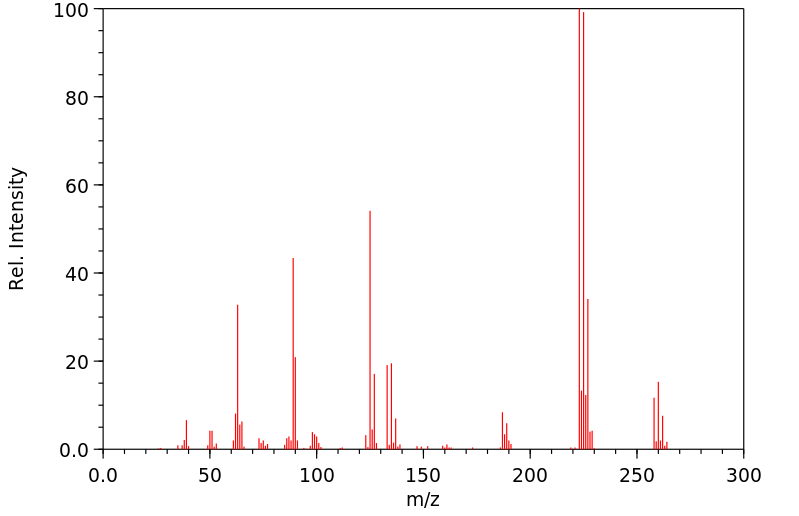三氯[4-(氯甲基)苯基]硅烷 | 13688-90-9
中文名称
三氯[4-(氯甲基)苯基]硅烷
中文别名
4-氯甲基苯基三氯硅烷;(对氯甲基苯基)三氯硅烷
英文名称
4-(chloromethyl)phenyltrichlorosilane
英文别名
(p-chloromethyl)phenyltrichlorosilane;trichloro[4-(chloromethyl)phenyl]silane;trichloro-[4-(chloromethyl)phenyl]silane
CAS
13688-90-9
化学式
C7H6Cl4Si
mdl
MFCD00045268
分子量
260.022
InChiKey
YBYBQFPZMKPGPJ-UHFFFAOYSA-N
BEILSTEIN
——
EINECS
——
-
物化性质
-
计算性质
-
ADMET
-
安全信息
-
SDS
-
制备方法与用途
-
上下游信息
-
文献信息
-
表征谱图
-
同类化合物
-
相关功能分类
-
相关结构分类
物化性质
-
沸点:142-144 °C15 mm Hg(lit.)
-
密度:1.361 g/mL at 25 °C(lit.)
-
闪点:78°C
-
稳定性/保质期:
计算性质
-
辛醇/水分配系数(LogP):4.16
-
重原子数:12
-
可旋转键数:1
-
环数:1.0
-
sp3杂化的碳原子比例:0.142
-
拓扑面积:0
-
氢给体数:0
-
氢受体数:0
安全信息
-
TSCA:Yes
-
危险等级:8
-
危险品标志:C
-
安全说明:S26,S27,S36/37/39,S45
-
危险类别码:R14,R34
-
WGK Germany:3
-
危险品运输编号:UN 2987 8/PG 2
-
海关编码:2931900090
-
包装等级:II
-
危险类别:8
SDS
上下游信息
-
上游原料
中文名称 英文名称 CAS号 化学式 分子量 对甲苯三氯硅烷 p-tolyltrichlorosilane 701-35-9 C7H7Cl3Si 225.577
反应信息
-
作为反应物:描述:三氯[4-(氯甲基)苯基]硅烷 在 水 作用下, 以 丙酮 为溶剂, 反应 48.0h, 生成 1,3,5,7,9,11,13,15-Octakis[4-(chloromethyl)phenyl]-2,4,6,8,10,12,14,16,17,18,19,20-dodecaoxa-1,3,5,7,9,11,13,15-octasilapentacyclo[9.5.1.13,9.15,15.17,13]icosane参考文献:名称:高度官能化的多面体低聚倍半硅氧烷的合成摘要:对-ClCH 2 C 6 H 4 SiCl 3在丙酮水溶液中的水解缩合反应产生[ p -ClCH 2 C 6 H 4 SiO 3/2 ] 8(1),这是一种合成八官能多面体低聚倍半硅氧烷的合成前体[ p -XCH 2 C 6 H 4 SiO 1.5 ] 8,包括2(X = I),3(X = OH),4(X = ONO 2),5(X = OAc),6(X =对硝基苯甲酰基)和7(X =甲基对苯二甲酰基)。DOI:10.1016/0022-328x(89)80022-1
-
作为产物:描述:参考文献:名称:Mozarew; Jakubowitsch, Zhurnal Obshchei Khimii, 1957, vol. 27, p. 2786,2789; engl. Ausg. S. 2822, 2824摘要:DOI:
文献信息
-
Spherical Supramolecular Structures Constructed via Chemically Symmetric Perylene Bisimides: Beyond Columnar Assembly作者:Jiahao Huang、Zebin Su、Mingjun Huang、Rongchun Zhang、Jian Wang、Xueyan Feng、Rui Zhang、Ruimeng Zhang、Wenpeng Shan、Xiao‐Yun Yan、Qing‐Yun Guo、Tong Liu、Yuchu Liu、Yunpeng Cui、Xiaopeng Li、An‐Chang Shi、Stephen Z. D. ChengDOI:10.1002/anie.201914889日期:2020.10.12molecules, self‐assembled supramolecular structures of perylene bisimides (PBIs) are commonly limited to columnar or lamellar structures due to their distinct π‐conjugated scaffolds and unique rectangular shape of perylene cores. The discovery of PBIs with supramolecular structures beyond layers and columns may expand the scope of PBI‐based materials. A series of unconventional spherical packing phases in像其他盘状分子一样,per双酰亚胺(PBI)的自组装超分子结构由于其独特的π共轭支架和unique核的独特矩形形状而通常限于柱状或层状结构。发现具有超越层和柱的超分子结构的PBI可能会扩展基于PBI的材料的范围。据报道,PBI中有一系列非常规的球形堆积相,包括A15相,σ相,十二边形准晶(DQC)相和体心立方(BCC)相。一种涉及用几个多面体低聚倍半硅氧烷(POSS)笼功能化per核的策略,由于在外围的空间位阻显着增加,因此实现了PBI的球形组装,而不是圆柱状组装。通过在其周边引入相似的庞大官能团,该策略也可用于发现其他相关盘状分子中的非常规球形组装体。通过提高退火温度,观察到了从BCC相到σ相的异常逆相变序列。
-
Silsesquioxane-bonded zirconocene complexes; soluble models for silica-tethered olefin polymerization catalysts作者:John R. Severn、Robbert Duchateau、Rutger A. van Santen、Dianne D. Ellis、Anthony L. Spek、Glenn P. A. YapDOI:10.1039/b300698k日期:——Silsesquioxane tethered fluorene ligands [R7Si8O12X]-9-Flu(H) (R = c-C6H11, X = – (1); R = c-C5H9, X = CH2 (2), (CH2)3 (3), C6H4CH2 (4)), (c-C5H9)7Si8O12CH2-9-Flu(9-EMe3) (E = Si (5a), Sn (5b)) and zirconium dichlorides Cp″[(c-C5H9)7Si8O12CH2-9-Flu]ZrCl2 (6b, Cp″ = 1,3-C5H3(SiMe3)2), Cp*[(c-C5H9)7Si8O12-X-9-Flu]ZrCl2 (X = CH2 (6a), (CH2)3 (7), C6H4CH2 (8)) and [(c-C5H9)7Si8O12CH2-9-Flu]2ZrCl2 (9) have been applied as models for silica-tethered ancillary ligands and silica tethered-zirconocenes. Immobilization of zirconocenes containing a pendant anchorable functionality, Cp″[Me2(EtO)SiCH2Flu]ZrCl2 (10) and Cp[C5Me4SiMe2OEt]ZrCl2 (11) was considerably hampered by competitive Zr–Cl and Si–OEt bond splitting. When activated with MAO (methylalumoxane), 6–9 yield active ethylene polymerization systems.Silsesquioxane 链接的氟烯配体 [R7Si8O12X]-9-Flu(H) (R = c-C6H11, X = – (1); R = c-C5H9, X = CH2 (2), ( )3 (3), C6H4 (4)), (c- )7Si8O12 -9-Flu(9-EMe3) (E = Si (5a), Sn (5b)) 和锆二氯化物 Cp″[(c- )7Si8O12 -9-Flu]ZrCl2 (6b, Cp″ = 1,3-C5H3(SiMe3)2), Cp*[(c- )7Si8O12-X-9-Flu]ZrCl2 (X = (6a), ( )3 (7), C6H4 (8)) 以及 [(c- )7Si8O12 -9-Flu]2ZrCl2 (9) 已被应用作为硅连接的辅助配体和硅连接的锆烯模型。 含有悬挂可锚定功能的锆烯的固定化,Cp″[Me2(EtO)Si Flu]ZrCl2 (10) 和 Cp[C5Me4SiMe2OEt]ZrCl2 (11) 受到竞争性 Zr–Cl 和 Si–OEt 键断裂的显著阻碍。当与 MAO(甲基铝氧烷)激活时,6–9 产生活性乙烯聚合系统。
-
What use for polysilsesquioxane lithium salts in lithium batteries?作者:Mathieu Meyer、Lydie Viau、Ahmad Mehdi、Sophie Monge、Patrick Judeinstein、André ViouxDOI:10.1039/c6nj00979d日期:——Aryl-containing lithium perfluorosulfonates form unquestionably a family of salts having fairly good electrochemical performances, especially high cation transference numbers. Here, this family was extended to polysilsesquioxanes in which every silicon atom bears one lithium perfluorosulfonate group, via a sol–gel synthesis involving an original organotrialkoxysilane salt precursor. Despite their high
-
Unexpected Elasticity in Assemblies of Glassy Supra‐Nanoparticle Clusters作者:Jia‐Fu Yin、Zhao Zheng、Junsheng Yang、Yuchu Liu、Linkun Cai、Qing‐Yun Guo、Mu Li、Xinpei Li、Tao Lin Sun、Geng Xin Liu、Caili Huang、Stephen Z. D. Cheng、Thomas P. Russell、Panchao YinDOI:10.1002/anie.202013361日期:2021.2.23remains unclear. Here, supra‐nanoparticle clusters (SNPCs) with precise structures are developed as model systems to elucidate the unexpected elastic behaviors. SNPCs are prepared by coordination‐driven assembly of polyhedral oligomeric silsesquioxane (POSS) with metal‐organic polyhedron (MOP). Due to the disparity in sizes, the POSS‐MOP assemblies, like their classic nanoparticles counterparts, ordering已知由密集堆积的颗粒组成的颗粒材料具有独特的机械性能,该机械性能高度依赖于颗粒的表面结构。对这些系统中结构与属性关系的微观理解仍不清楚。在这里,具有精确结构的超纳米粒子簇(SNPC)被开发为模型系统,以阐明意想不到的弹性行为。SNPC是通过多金属低聚倍半硅氧烷(POSS)与金属有机多面体(MOP)的协调驱动组装而制备的。由于尺寸上的差异,POSS-MOP组件像其经典的纳米颗粒组件一样,被抑制了有序排列,并且POSS-MOP混合物会随着温度的降低而玻璃化或阻塞。对于具有高模量的SNPC组件,观察到了意外的弹性,该弹性被维持在远远超过玻璃化转变温度的温度下。通过对SNPC的层次结构的动力学研究和分子动力学模拟,弹性起源于POSS末端臂的互穿。物理分子互穿和互锁现象有利于新型簇基弹性体的便捷解决方案或压制工艺。
-
Self‐assembly and secondary structures of linear polypeptides tethered to polyhedral oligomeric silsesquioxane nanoparticles through click chemistry作者:Yung‐Chih Lin、Shiao‐Wei KuoDOI:10.1002/pola.24640日期:2011.5.15In this study, we used click chemistry to synthesize a new macromolecular self‐assembling building blocks, linear polypeptide‐b‐polyhedral oligomeric silsesquioxane (POSS) copolymers, from a mono‐azido–functionalized POSS (N3‐POSS) and several alkyne‐poly(γ‐benzyl‐L‐glutamate) (alkyne‐PBLG) systems. The incorporation of the POSS unit at the chain end of the PBLG moiety allowed intramolecular hydrogen在这项研究中,我们使用点击化学从单叠氮基官能化POSS(N 3 -POSS)和几种炔烃中合成了一种新的大分子自组装结构单元,即线性多肽b多面体低聚倍半硅氧烷(POSS)共聚物。聚(γ-苄基-L-谷氨酸)(炔烃-PBLG)系统。通过傅立叶变换红外光谱法和广角测定,在PBLG部分链末端引入POSS单元可使POSS和PBLG单元之间发生分子内氢键结合,从而增强固态的α螺旋构象。 X射线衍射分析。POSS‐ b‐PBLG经过分层自组装,其特征在于使用小角度X射线散射,形成了具有α-螺旋或β-sheet构象和POSS聚集体的双层纳米结构。热重分析表明,引入POSS部分后,热降解温度显着升高,这大概是在纳米复合材料表面上形成了无机保护层。©2011 Wiley Periodicals,Inc. J Polym Sci A部分:Polym Chem,2011年
表征谱图
-
氢谱1HNMR
-
质谱MS
-
碳谱13CNMR
-
红外IR
-
拉曼Raman
-
峰位数据
-
峰位匹配
-
表征信息
同类化合物
(βS)-β-氨基-4-(4-羟基苯氧基)-3,5-二碘苯甲丙醇
(S,S)-邻甲苯基-DIPAMP
(S)-(-)-7'-〔4(S)-(苄基)恶唑-2-基]-7-二(3,5-二-叔丁基苯基)膦基-2,2',3,3'-四氢-1,1-螺二氢茚
(S)-盐酸沙丁胺醇
(S)-3-(叔丁基)-4-(2,6-二甲氧基苯基)-2,3-二氢苯并[d][1,3]氧磷杂环戊二烯
(S)-2,2'-双[双(3,5-三氟甲基苯基)膦基]-4,4',6,6'-四甲氧基联苯
(S)-1-[3,5-双(三氟甲基)苯基]-3-[1-(二甲基氨基)-3-甲基丁烷-2-基]硫脲
(R)富马酸托特罗定
(R)-(-)-盐酸尼古地平
(R)-(-)-4,12-双(二苯基膦基)[2.2]对环芳烷(1,5环辛二烯)铑(I)四氟硼酸盐
(R)-(+)-7-双(3,5-二叔丁基苯基)膦基7''-[((6-甲基吡啶-2-基甲基)氨基]-2,2'',3,3''-四氢-1,1''-螺双茚满
(R)-(+)-7-双(3,5-二叔丁基苯基)膦基7''-[(4-叔丁基吡啶-2-基甲基)氨基]-2,2'',3,3''-四氢-1,1''-螺双茚满
(R)-(+)-7-双(3,5-二叔丁基苯基)膦基7''-[(3-甲基吡啶-2-基甲基)氨基]-2,2'',3,3''-四氢-1,1''-螺双茚满
(R)-(+)-4,7-双(3,5-二-叔丁基苯基)膦基-7“-[(吡啶-2-基甲基)氨基]-2,2”,3,3'-四氢1,1'-螺二茚满
(R)-3-(叔丁基)-4-(2,6-二苯氧基苯基)-2,3-二氢苯并[d][1,3]氧杂磷杂环戊烯
(R)-2-[((二苯基膦基)甲基]吡咯烷
(R)-1-[3,5-双(三氟甲基)苯基]-3-[1-(二甲基氨基)-3-甲基丁烷-2-基]硫脲
(N-(4-甲氧基苯基)-N-甲基-3-(1-哌啶基)丙-2-烯酰胺)
(5-溴-2-羟基苯基)-4-氯苯甲酮
(5-溴-2-氯苯基)(4-羟基苯基)甲酮
(5-氧代-3-苯基-2,5-二氢-1,2,3,4-oxatriazol-3-鎓)
(4S,5R)-4-甲基-5-苯基-1,2,3-氧代噻唑烷-2,2-二氧化物-3-羧酸叔丁酯
(4S,4''S)-2,2''-亚环戊基双[4,5-二氢-4-(苯甲基)恶唑]
(4-溴苯基)-[2-氟-4-[6-[甲基(丙-2-烯基)氨基]己氧基]苯基]甲酮
(4-丁氧基苯甲基)三苯基溴化磷
(3aR,8aR)-(-)-4,4,8,8-四(3,5-二甲基苯基)四氢-2,2-二甲基-6-苯基-1,3-二氧戊环[4,5-e]二恶唑磷
(3aR,6aS)-5-氧代六氢环戊基[c]吡咯-2(1H)-羧酸酯
(2Z)-3-[[(4-氯苯基)氨基]-2-氰基丙烯酸乙酯
(2S,3S,5S)-5-(叔丁氧基甲酰氨基)-2-(N-5-噻唑基-甲氧羰基)氨基-1,6-二苯基-3-羟基己烷
(2S,2''S,3S,3''S)-3,3''-二叔丁基-4,4''-双(2,6-二甲氧基苯基)-2,2'',3,3''-四氢-2,2''-联苯并[d][1,3]氧杂磷杂戊环
(2S)-(-)-2-{[[[[3,5-双(氟代甲基)苯基]氨基]硫代甲基]氨基}-N-(二苯基甲基)-N,3,3-三甲基丁酰胺
(2S)-2-[[[[[((1S,2S)-2-氨基环己基]氨基]硫代甲基]氨基]-N-(二苯甲基)-N,3,3-三甲基丁酰胺
(2S)-2-[[[[[[((1R,2R)-2-氨基环己基]氨基]硫代甲基]氨基]-N-(二苯甲基)-N,3,3-三甲基丁酰胺
(2-硝基苯基)磷酸三酰胺
(2,6-二氯苯基)乙酰氯
(2,3-二甲氧基-5-甲基苯基)硼酸
(1S,2S,3S,5S)-5-叠氮基-3-(苯基甲氧基)-2-[(苯基甲氧基)甲基]环戊醇
(1S,2S,3R,5R)-2-(苄氧基)甲基-6-氧杂双环[3.1.0]己-3-醇
(1-(4-氟苯基)环丙基)甲胺盐酸盐
(1-(3-溴苯基)环丁基)甲胺盐酸盐
(1-(2-氯苯基)环丁基)甲胺盐酸盐
(1-(2-氟苯基)环丙基)甲胺盐酸盐
(1-(2,6-二氟苯基)环丙基)甲胺盐酸盐
(-)-去甲基西布曲明
龙蒿油
龙胆酸钠
龙胆酸叔丁酯
龙胆酸
龙胆紫-d6
龙胆紫







